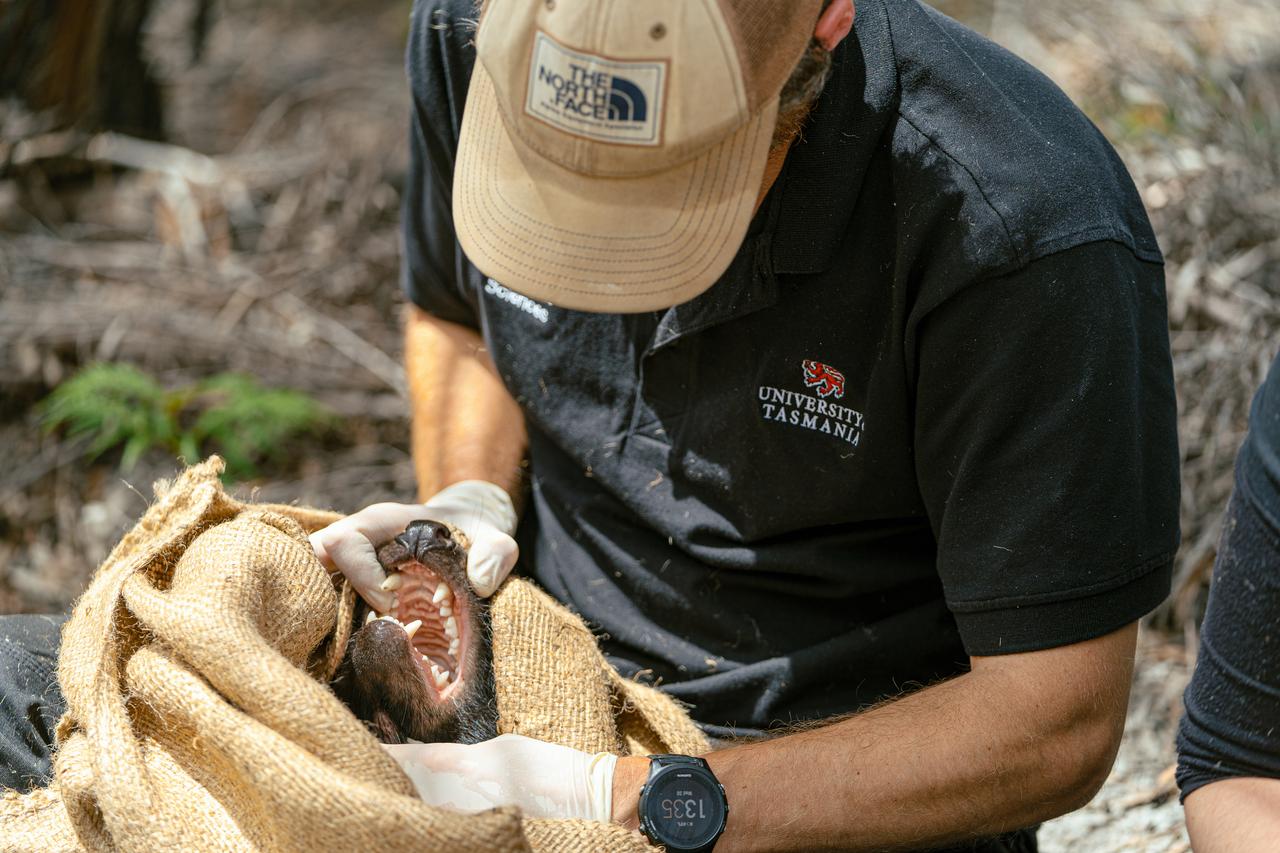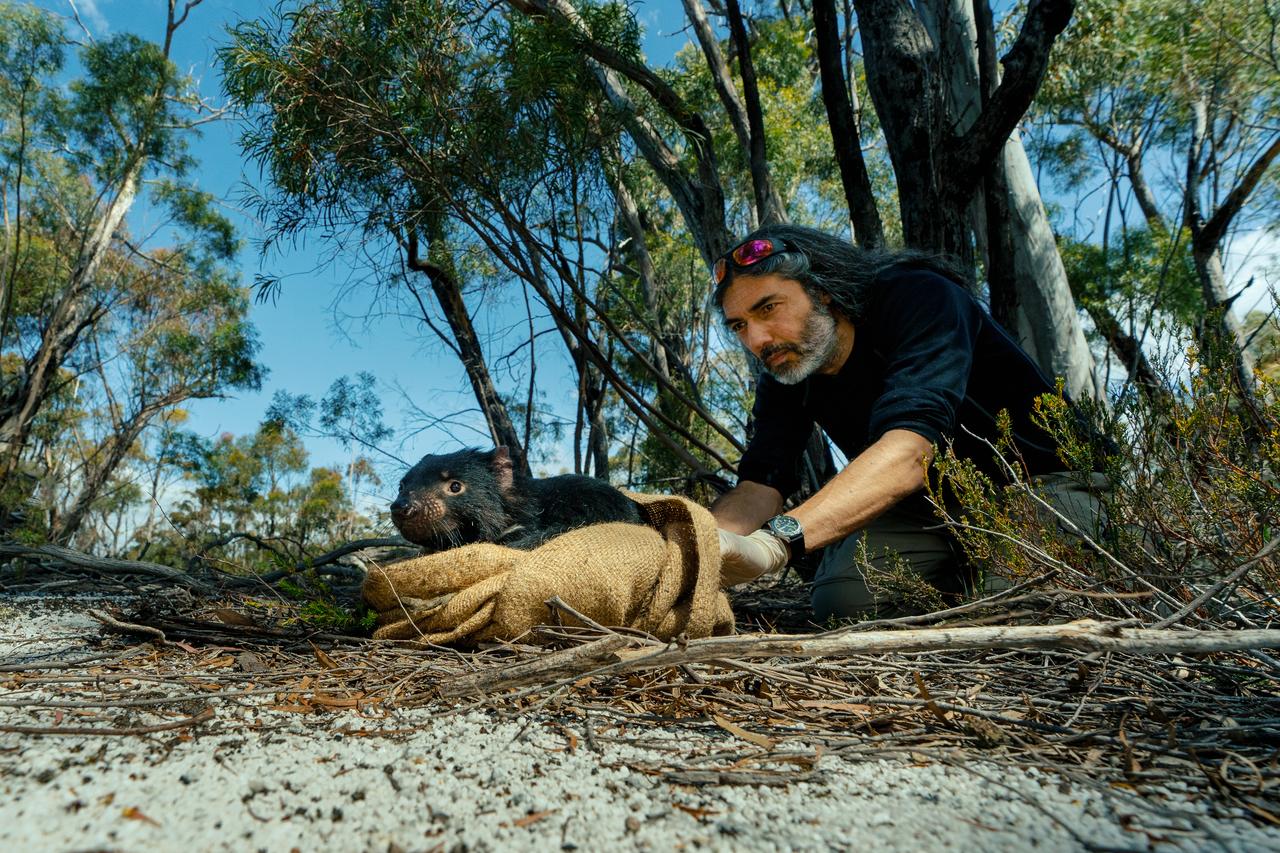Facial tumours evolve to coexist with Tasmanian devil populations.
The deadly cancer that has been affecting devil populations for almost three decades has been subject to mutations that are allowing devils to persist in long-term affected areas.
An international team from Australia, France and USA analysed the tumour genomes of a devil population in northwest Tasmanian, West Pencil Pine, that has been affected by devil facial tumour disease (DFTD) since 2006.
The study, led by the University of Tasmania, analysed data from 159 tumour genomes to assess the dynamics of tumour variants during the course of the epidemic.
University of Tasmania School of Natural Sciences disease ecologist Dr Rodrigo Hamede said that shortly after its arrival to West Pencil Pine, DFTD reached its peak of genetic diversity.
“Over time, some DFTD variants were weeded out, while a few became better adapted and fixed in the population. This coincided with lower infection rates and devil population decline levelling off” he said.
Dr Hamede argues that the results could be due to differences in virulence and transmissibility among tumour variants, devils developing resilience against DFTD, or a combination of both.
“In the past we have observed genetic adaptations in the devil, which have allowed them to persist despite the deadly cancer”, he said.
“Now we have evidence that, through natural selection, the tumour is fine tuning its optimal virulence, a trade-off between transmission rate and disease-induced mortality”.
“This means that DFTD is very unlikely to drive the devil to extinction, but it also means the disease will not disappear, it’s an evolutionary deal between the two to coexist with each other.”
Co-author Dr Nick Fountain-Jones, a disease evolutionary ecologist from the University of Tasmania, said that the study shows how useful tumour genomes can be in helping us to understand disease dynamics.
“The SARS CoV-2 virus has shown the importance of genomics in understanding pandemic patterns, and in this work, we show that similar approaches can be used to gain new insights into the epidemiology of infectious cancers”.
“For example, just using tumour genomics (and some clever maths) we were able to work out when the deadly tumour arrived in the population.”

Implications for conservation strategies
Dr Hamede said that the research proves that evolutionary processes can lead to the coexistence of host populations and diseases, even when disease-induced mortality is extremely high, such as in DFTD.
“Our results suggest that in the absence of management interventions, devils and DFTD can coexist with each other. However, we have already lost two-thirds of the devil population we had prior to the emergence of DFTD, so being complacent about their conservation status is not an option”.
“We need to make sure we reduce all other threatening processes, such has habitat loss and fragmentation, genetic deterioration in local populations and roadkill. Extinctions are rarely driven by one factor, but act in synergy with other threatening processes,” Dr Hamede said.
“Furthermore, we cannot discount the possibility that future changes in tumour variants might alter infection dynamics. The evolutionary outcomes we have seen are not fixed, in evolutionary timescales, this disease is still in its infancy”.
Dr Hamede thinks that there should be a paradigm shift in devil conservation.
“The strongholds of devil populations are not necessarily those few isolated populations where DFTD has not reached yet. Long-term diseased populations, where tumours and devils are becoming increasingly adapted to live with each other and are of high conservation value. These are the populations that we need to look after, as they possess key adaptive traits for future generations.”
The path to devil recovery is not certain yet. Devils are facing a second and independently evolved transmissible cancer, devil facial tumour 2 (DFT2) which was first observed in 2014 near Cygnet, in south-eastern Tasmania.
“So far, the adaptive processes we have observed in response to the epidemic have been in relation to DFTD, but we know very little about DFT2. Whether these DFTD-adaptations are transferrable to DFT2 remains unknown.”
The University of Tasmania team has been monitoring the spread of DFT2 through the Kingborough and Huon Valley councils since 2016.
“Surveying populations in urbanised areas is another challenge,” Dr Hamede said.
“However, we have been lucky to have the generous support from more than 300 private landowners. The broader community has kindly opened their doors for us to continue monitoring the spread and impact of DFT2”.

An international team studying cancer ecology and evolution
The University of Tasmania is part of an international associated lab, dedicated to study ecological and evolutionary processes in cancer.
Co-author Professor Frédéric Thomas from the French National Centre for Scientific Research (CNRS) and head of the Centre for Research in Cancer Ecology and Evolution said that transmissible cancers such as DFTD and DFT2 represent a unique model system to study how host-cancer selective processes emerge and evolve in nature.
“Transmissible cancers are equivalent to metastases between individuals, but once the transmission process has begun, it is also equivalent to a new form of life generated by the cancer. Incredible as it may seem, the cancer is in this case a new source of life, although parasitic.”
Professor Thomas says that studying the evolution of transmissible cancers has broader implications for oncology as they may help to understand the evolutionary potential contained in tumours and the resulting metastatic cascades in non-transmissible cancers.
This study ‘The tumour is in the detail: local phylogenetic, population and epidemiological dynamics of a transmissible cancer in Tasmanian devils’ was published in the journal Evolutionary Applications, and authored by Rodrigo Hamede, Nicholas Fountain-Jones, Fernando Arce, Menna Jones, Andrew Storfer, Paul A. Hohenlohe, Hamish McCallum, Benjamin Roche, Beata Ujvari, Frédéric Thomas.
See the University of Tasmania media release about this research.


